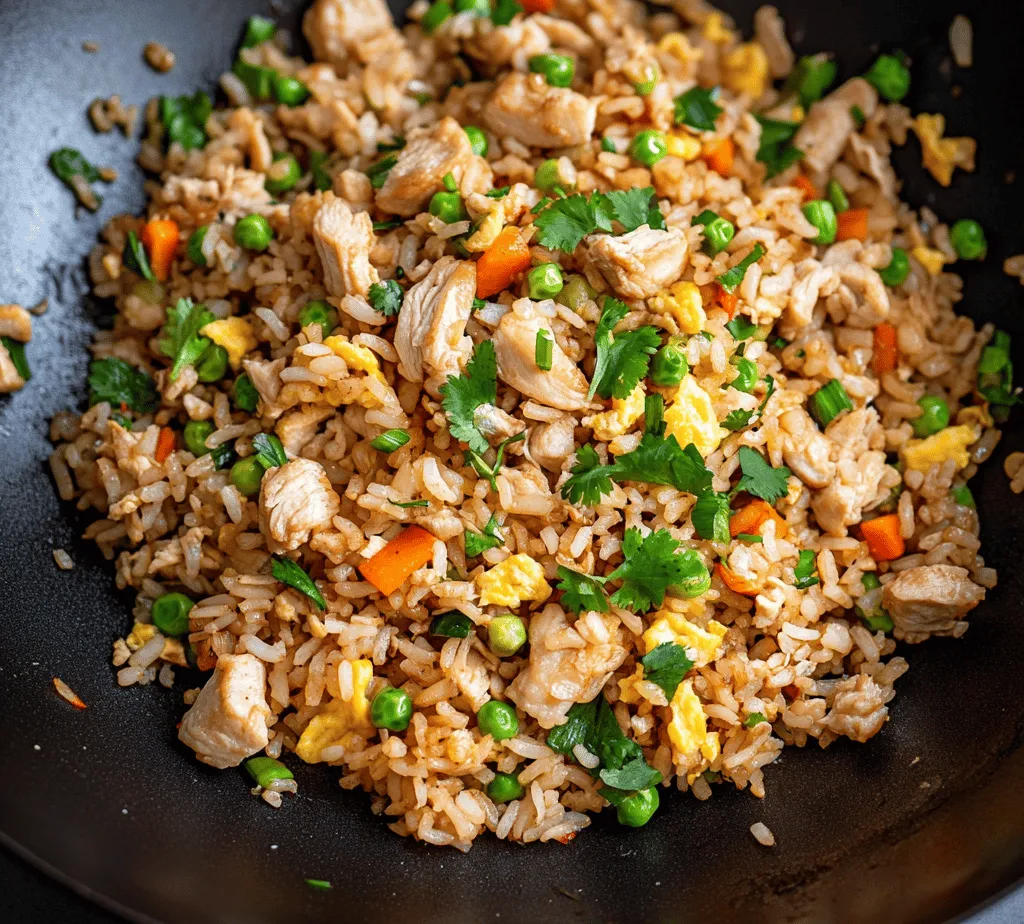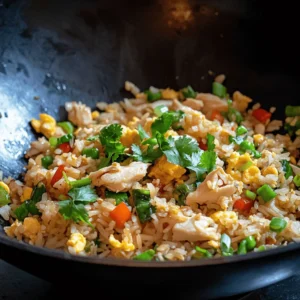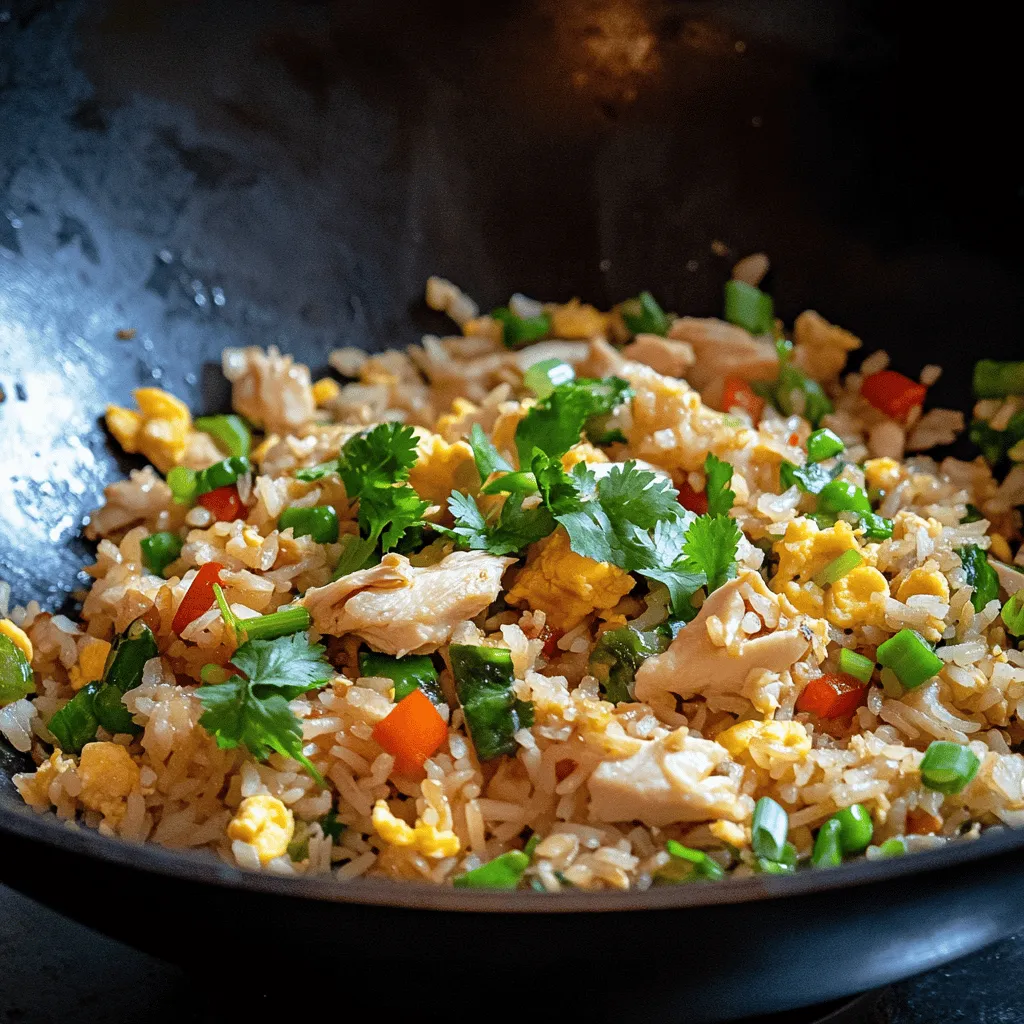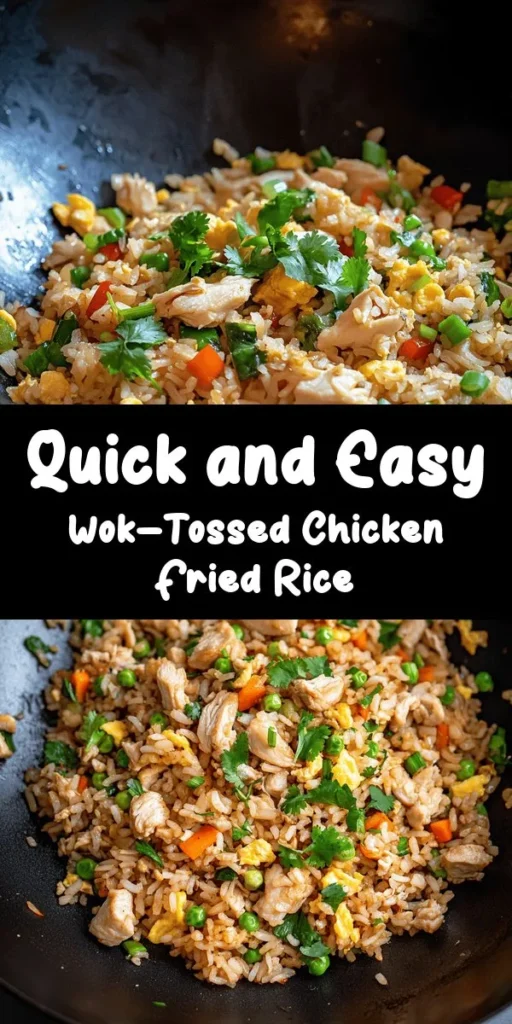Introduction
Fried rice is a beloved staple in Chinese cuisine, celebrated across the globe for its delightful combination of flavors and textures. From bustling street food stalls in Beijing to five-star restaurants in New York City, this dish has made its mark as a versatile and satisfying meal option. Among the myriad of fried rice variations, chicken fried rice stands out as a comfort food favorite, bringing warmth and nostalgia to many dinner tables.
This dish is particularly appealing for busy families and meal prep enthusiasts, as it can be whipped up in a flash, utilizing a range of ingredients and easily adapting to what’s available in your pantry. Whether you have leftover chicken from last night’s dinner or a bag of frozen mixed vegetables, chicken fried rice is a delightful way to make the most of your resources while delivering a hearty meal.
In this recipe, we will dive into the unique flavors and key ingredients that make our wok-tossed Chinese chicken fried rice a standout dish. The combination of tender chicken, colorful vegetables, and fragrant jasmine rice, all tossed together in a hot wok, creates an unforgettable culinary experience. Here, we’ll showcase how these elements come together to create a dish that not only tastes amazing but is also quick and easy to prepare.
Understanding the Ingredients
To achieve the perfect wok-tossed chicken fried rice, it’s essential to understand the primary ingredients that contribute to its deliciousness.
Jasmine Rice
At the heart of any great fried rice dish is the rice itself, and jasmine rice is the preferred choice for many. Known for its fragrant aroma and slightly sticky texture, jasmine rice provides the perfect base for absorbing the flavors of the accompanying ingredients. One crucial tip when preparing fried rice is to use day-old rice. Freshly cooked rice tends to be too moist and sticky, resulting in a clumpy texture when stir-fried. Day-old rice, on the other hand, has had time to cool and dry out, allowing each grain to separate and maintain its structure during the high-heat cooking process.
If you don’t have day-old rice on hand, you can cool freshly cooked rice by spreading it out on a baking sheet and placing it in the refrigerator for about 30 minutes to an hour. This simple technique helps create the ideal texture for your fried rice.
Chicken
Chicken is the star protein in this recipe, and there are several options to consider. You can use leftover roasted chicken, poached chicken, or even store-bought rotisserie chicken for a quick and easy option. The beauty of this dish is its flexibility; you can incorporate whatever chicken you have on hand, making it a perfect dish for utilizing leftovers. Shredded or diced chicken adds a satisfying heartiness to the dish and pairs beautifully with the other ingredients.
Vegetables
A colorful medley of vegetables not only enhances the visual appeal of your chicken fried rice but also adds essential nutrients and flavors. While you can certainly use fresh produce like peas, carrots, and bell peppers, frozen mixed vegetables can be a convenient alternative, making it easy to whip up the dish on a busy weeknight. Incorporating vegetables not only adds texture and flavor but also provides a well-rounded meal packed with vitamins.
Sauces
The secret to elevating your chicken fried rice lies in the sauces used. A combination of soy sauce, oyster sauce, and sesame oil creates a complex flavor profile that is both savory and rich. Soy sauce is a staple in Chinese cooking, providing umami flavor and color to the dish. Oyster sauce adds a hint of sweetness and depth, while sesame oil offers a nutty aroma that ties everything together. These sauces are essential for enhancing the overall taste of the dish, so don’t skip them!
Optional Ingredients
While the core ingredients provide a solid foundation for chicken fried rice, there are various optional ingredients you can include to customize your dish. For instance, adding scrambled eggs can introduce a creamy texture and additional protein. You could also consider tossing in fresh herbs, like green onions or cilantro, for a burst of freshness. If you enjoy a bit of heat, a dash of chili paste or sriracha can offer a spicy kick. The beauty of fried rice lies in its adaptability, so feel free to get creative with the ingredients you choose.
Preparation Techniques
Before we dive into the cooking process, let’s discuss some essential preparation techniques that will set you up for success.
Importance of Preparing Rice Correctly
As mentioned earlier, the texture of your rice plays a crucial role in the final outcome of your chicken fried rice. Starting with day-old rice is ideal, but if you need to use freshly cooked rice, cooling it properly is key. Spread the rice out in a thin layer on a baking sheet to help it cool quickly and evenly. This prevents it from clumping together when you start frying.
Cooking in a Wok vs. Using a Skillet
While you can certainly prepare chicken fried rice in a skillet, using a wok is the traditional method and offers several advantages. A wok’s high, sloped sides allow for even heat distribution and provide ample space for tossing ingredients without spilling. The design of the wok also enables better airflow during cooking, which is essential for achieving that coveted “wok hei” or “breath of the wok” flavor that is characteristic of stir-fried dishes.
When using a skillet, you’ll need to be cautious about overcrowding the pan, which can lead to steaming rather than frying. If you’re cooking for a crowd or want to make a larger batch, a wok is undoubtedly the way to go.
Advantages of Using a Wok for Stir-Frying
Stir-frying is a high-heat cooking technique that requires precision and speed. The wok’s design allows for quick cooking while maintaining the integrity of the ingredients. The large surface area means you can cook multiple ingredients at once without losing heat, which is essential for achieving the perfect fried rice. The key is to ensure that your wok is preheated before adding any ingredients; a hot wok will create a beautiful sear on the chicken and vegetables, enhancing the overall flavor of the dish.
Step-by-Step Cooking Instructions
Now that we have covered the ingredients and essential preparation techniques, it’s time to dive into the step-by-step cooking process. Follow these detailed instructions to create your very own wok-tossed chicken fried rice.
Preparing the Wok and Heating Oil
1. Heat the Wok: Start by placing your wok over high heat. Allow it to heat up for about 1-2 minutes until it becomes hot. You can test the heat by flicking a few drops of water into the wok; if they evaporate immediately, it’s ready for cooking.
2. Add Oil: Once the wok is hot, add a high smoke-point oil like vegetable oil or peanut oil. Swirl the oil around the surface of the wok to ensure it coats the bottom evenly. You’ll want about 2 tablespoons of oil to prevent sticking and facilitate the stir-frying process.
3. Temperature Control: It’s essential to maintain high heat throughout the cooking process. If at any point the oil begins to smoke excessively, reduce the heat slightly to prevent burning your ingredients.
With these initial steps in place, you’re ready to embark on creating a delicious wok-tossed Chinese chicken fried rice that will surely impress your family and friends. Stay tuned for the next part, where we’ll continue with the step-by-step cooking instructions that will bring this delightful dish to life!

Scrambling the Eggs: Techniques for Perfect Scrambled Eggs in Fried Rice
To achieve the ideal scrambled eggs in your wok-tossed Chinese chicken fried rice, it’s essential to use the right technique. Start by cracking the eggs into a bowl and whisking them until the yolks and whites are fully combined. Season with a pinch of salt and pepper to enhance the flavor.
When it’s time to cook, heat a tablespoon of oil in your wok over medium-high heat. Swirl the oil to coat the surface, and then pour in the beaten eggs. Allow the eggs to sit undisturbed for a few seconds, then gently stir with a spatula, pushing the cooked edges towards the center. This method ensures that the eggs remain fluffy rather than becoming rubbery. Cook just until the eggs are softly set; they will continue to cook when added back into the fried rice later. Remove the scrambled eggs from the wok and set them aside, ready to be folded into the dish at the end.
Sautéing Aromatics: Importance of Garlic for Flavor Infusion
Garlic is a fundamental ingredient in many Asian cuisines, and it plays a critical role in flavoring your chicken fried rice. After setting the eggs aside, add a bit more oil to the wok if necessary and increase the heat to high. Add minced garlic to the hot oil and sauté for just a minute until it becomes fragrant. Be careful not to burn the garlic, as this can impart a bitter taste to the dish.
The beauty of sautéing garlic lies in its ability to infuse the oil with flavor, creating a rich base for the rest of your ingredients. Once the garlic is aromatic, it’s time to move on to the next step.
Cooking Chicken and Vegetables: Timing and Techniques for Even Cooking
With the garlic now fragrant, it’s time to add the chicken. Cut your chicken breast into small, bite-sized pieces to ensure even cooking. Add the chicken to the sizzling wok, spreading it out in a single layer. This allows the chicken to sear properly and develop a nice golden color. Cook the chicken for about 5-7 minutes or until it is no longer pink in the center.
Once the chicken is cooked through, it’s time to add your vegetables. Common choices include diced carrots, peas, and bell peppers. Add these to the wok and stir-fry for another 2-3 minutes until the vegetables are tender-crisp. This timing is crucial; overcooking can lead to mushy vegetables, while undercooking may leave them too raw to enjoy.
Integrating Rice and Sauces: Tips for Achieving the Right Consistency and Flavor Balance
After your chicken and vegetables are cooked, it’s time to add the rice. Ideally, you should use day-old rice as it has had time to dry out in the refrigerator, which will help prevent clumping. If you’re using freshly cooked rice, spread it out on a baking sheet and let it cool for at least 30 minutes.
Add the rice to the wok and break up any clumps using your spatula. Stir-fry the rice with the chicken and vegetables for about 5 minutes to combine the flavors. To season the fried rice, add soy sauce, oyster sauce, and sesame oil, adjusting the amounts to taste. The soy sauce adds saltiness, while the oyster sauce lends a hint of sweetness and depth. Stir continuously to ensure that the rice absorbs the sauces evenly, achieving a perfect balance of flavors.
Final Touches: Incorporating Eggs and Green Onions for Freshness
As the rice becomes heated through and fully mixed with the sauces, it’s time to reintroduce the scrambled eggs. Gently fold the eggs into the rice mixture, ensuring they are evenly distributed without breaking them up too much.
For a burst of freshness, add chopped green onions at this stage. The green onions not only provide a pop of color but also add a mild onion flavor that complements the dish beautifully. Stir everything together for another minute, allowing the green onions to soften slightly.
Flavor Enhancements and Variations
Suggestions for Customizing the Dish
One of the great things about fried rice is its versatility. You can customize the dish according to your taste preferences or dietary needs. Consider adding a splash of rice vinegar for a hint of acidity or a drizzle of chili oil for a spicy kick.
Alternative Proteins: Tofu, Shrimp, or Beef Options
If you’re looking to switch up the protein, consider using tofu for a vegetarian option. Press and cube firm tofu, then sauté until golden before adding it to the rice. Shrimp is another excellent choice; just be sure to cook it briefly to avoid overcooking. For beef lovers, thinly sliced flank steak can be marinated and stir-fried in place of chicken.
Vegetarian and Vegan Adaptations: Omitting Chicken and Using Plant-Based Sauces
To make a vegetarian or vegan version of this dish, simply omit the chicken and use vegetable broth instead of chicken broth in the sauces. There are many plant-based sauces available that mimic the flavor of oyster sauce, or you can use hoisin sauce for a sweet and savory alternative.
Adding Unique Ingredients: Suggestions for Spices, Herbs, or Extra Vegetables
Feel free to experiment with other vegetables such as broccoli, zucchini, or snow peas. Adding spices like five-spice powder or a sprinkle of cumin can introduce new flavor dimensions to your fried rice. Fresh herbs like cilantro or basil can also be folded in right before serving for an aromatic finish.
Nutritional Aspects
Overview of the Nutritional Benefits of the Dish
Wok-tossed Chinese chicken fried rice is not only delicious but also nutritious. It provides a balanced meal that combines protein from chicken and eggs, carbohydrates from rice, and essential vitamins and minerals from vegetables.
Balanced Meal: Discussing Protein, Carbohydrates, and Vitamins from Vegetables
This dish offers a wholesome balance of macronutrients. The chicken and eggs contribute high-quality protein, essential for muscle repair and growth. Meanwhile, the rice serves as a great source of energy, while the vegetables provide vital vitamins such as A, C, and K, as well as dietary fiber, which is important for digestion.
Healthier Cooking Options: Tips on Reducing Oil or Sodium Content
For those looking to make this dish lighter, consider using less oil during the cooking process or opting for a non-stick wok. You can also reduce the amount of soy sauce or use low-sodium versions to cut back on sodium content without sacrificing flavor.
Serving Suggestions
Ideas for Side Dishes that Complement Chicken Fried Rice
To create a complete meal, consider serving your chicken fried rice with a side of steamed dumplings, spring rolls, or a light cucumber salad. These side dishes not only pair well but also enhance the overall dining experience.
Presentation Tips for an Appealing Serving Style
When it comes to presentation, consider serving the fried rice in a large, shallow bowl. This allows the vibrant colors of the ingredients to shine through. Garnish with additional chopped green onions and a sprinkle of sesame seeds for an attractive finish.
Suggestions for Garnishes that Enhance Flavor and Visual Appeal
To elevate the flavor and presentation, add a drizzle of soy sauce or chili oil over the top just before serving. Fresh herbs such as cilantro or basil can add a bright touch, while lime wedges provide a zesty contrast that guests can squeeze over their portions.
Conclusion
Wok-tossed Chinese chicken fried rice is more than just a quick meal; it’s a delicious and versatile dish that can be tailored to suit any palate. Its combination of flavors, textures, and the ability to incorporate various ingredients make it a beloved staple in Chinese cuisine.
Whether you follow the traditional recipe or experiment with your unique variations, this fried rice dish is sure to impress. So, don your apron and get ready to bring the flavors of a Chinese kitchen into your home. Don’t be afraid to experiment with personal touches, as each adaptation can lead to delightful new discoveries in flavor. Enjoy the process, and savor the satisfaction that comes with creating a dish that your family and friends will love!



